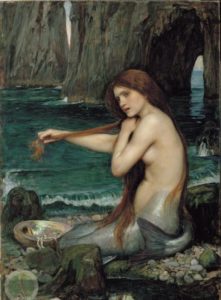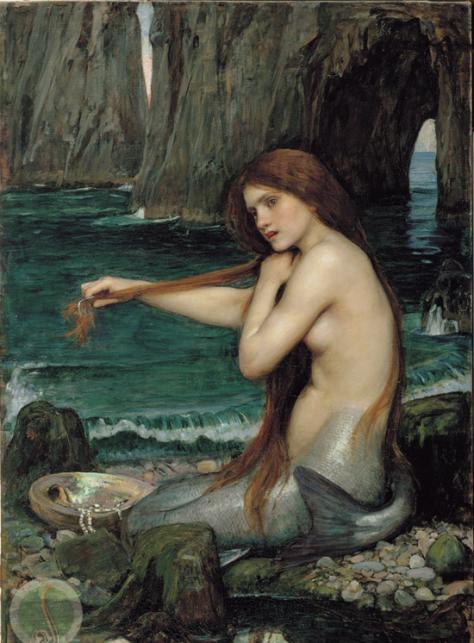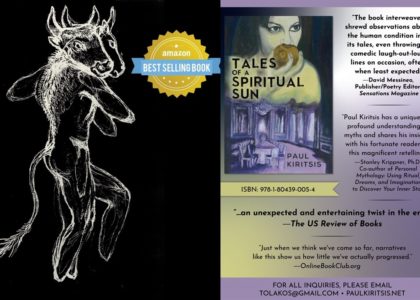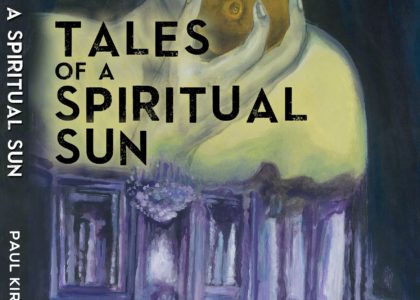
As we’ve discussed in the opening blog of the “It’s all Greek to me” series, the ancient Greeks saw their gods and goddesses as archetypal powers that existed in the world of “being” and manifested through its conscious extensions (and sometimes independently of them). The personification of natural forces on the part of these archetypal powers—forces identified both in the earth and in the recesses of humanity’s unconscious mind—were supernatural in that they unveiled a tangible connection between the earth’s natural cycles, its electromagnetic fields and the higher Self.
Belief in spirits of nature is probably as old as our coming to consciousness, for they would have contextualized Mother Nature in a way that made her accessible, perceptible and entirely meaningful to the differentiating human ego and the tribal mentality of Paleolithic times. The spirits confined to the sphere of nature were the nymphs. These supra-natural forces were known as dryads when they pervaded the thick woodlands and forests; Nereids when they inhabited the ocean or the sea caves; oreads when they wondered ceaselessly across the mountains. Limoniads presided over meadows, and limniads over lakes, marshes and swamps. Naiads or water nymphs inhabited village streams and rivers. In modern-day Greece, one finds many stories of hauntings near water, particularly streams and rivers. It’s not uncommon for townsfolk to refer to the Nereid of the village well or stream by name, as though she were actually part of the human populace.
As with a great many other generative powers, it appears that nymphs were especially connected with water. In fact, it wouldn’t be wrong to state that the entire goddess tradition is hinged upon birth of feminine entities from the volatile element. The primeval Sumarian Goddess Nammu was represented by the hieroglyphic figure for water. The Great Mother Goddesses of Egypt, Nut and Hathor, were originally sky goddesses and the sky was imagined by the Paleolithic peoples to be the celestial equivalent of the ocean. Mighty Isis, the most important sotirological figure of Alexandrian Egypt was born from the primordial waters of chaos. Aphrodite was born from the froth of the sea. Even Maria, the feminine representative of the Christian Godhead, retains memory of the sea in the etymology of her name. Maria derives from mare, the Latin word for the sea and links the Holy Virgin of Christian tradition to the Great Mother Goddesses of other pre-Christian traditions.
In the cycle of myths attributed to the indigenous Inuit people of Canada and Greenland, the sea was commanded by the spirit of a woman-turned-goddess called Sedna. Atargatis, a Semitic moon goddess, was the first feminine deity to assume the form of a mermaid. She laid the foundations for the folklore surrounding the Celtic Liban and the Mermaid of Iona which came thousands of years afterward. The greatest seafaring peoples of any one time have always been acutely fixated by them. Mermaids themselves are simply unconscious personifications of the original connection between the feminine Godhead who created the entire universe and her watery womb from whence it emerged.
In antiquity, the Nereids were sea nymphs, the fifty daughters of Nereus and Doris who dwelled in the Mediterranean Sea. Many people believed they were of friendly disposition and helped in averting perilous storms. Their growing presence in art, architecture, and in the psyche of ancient sailors proved disadvantageous to the plight of the Christian priests, who, fighting to suppress pagan virtues many centuries afterward, were unable to eradicate them from popular folklore. One need only take a good look at the number of water deities in the classical pantheon of gods to contemplate the extent of this eternal obsession, one initiated by the Minoan thalassokratia and inherited by the classical, Byzantine, and contemporary Greeks who came after them.
Of the four elements known to the ancients, water appears to be the one that was least understood. How could something placid and fair one minute, stirring the reverence and admiration of ancient poets and playwrights, become a wrathful agent of death and destruction the next? Greeks believed that the pelagic waters could never be trusted or taken at face value; if anything, they had to be feared. This idea is entombed in one particular line of an aretalogy of the Hellenistic Isis: “I make the navigable un-navigable whenever I so desire.” Ultimately, it was this innate fear, coupled with the adventuresome and often very vivid imagination of most sailors, that forever impressed upon the collective psyche of Hellenes their erroneous beliefs that the seas were haunted by Nereids, giant serpents, and other prehistoric creatures.
One that was distinctly Greek was the legend of the Gorgona, an overgrown mermaid lurking in the abyssal depths of both the Black and Aegean Seas. One that was distinctly Greek was the legend of the Gorgona, an overgrown mermaid lurking in the abyssal depths of both the Black and Aegean Seas. This Nereid was the alleged sister of Alexander the Great. During a time when she was still a mortal woman, she conspired with her brother to steal a flask containing the waters of eternal life from a cave that was guarded by a gruesome dragon. Their plot succeeded, albeit fleetingly. The Gorgona snuck into the cave and snatched up the flask but dropped it in her haste to get away, unaware that the fiend no longer posed a threat because Alexander had slain it. When Alexander saw the flask’s contents spilled onto the ground, he cursed her repeatedly. His fury was such that it carried the potency of magical incantation and turned her into a theriomorph—a creature who was part-woman, part-fish and thereafter inhabited the seas. If the Gorgona caught sight of a passing ship, she would propel herself to the sea surface holding a trident and appear beside the hull in her guise of femme fatale, asking the ship’s captain, ‘Does King Alexander live?’ If the captain replied, ‘He lives and conquers,’ the Gorgona would become spirited with rhapsody, taming the whirlwinds and greybeards with her smile and playing blissful tunes on her lyre. If he made the fatal mistake of telling her that her brother was dead, she would become wracked by grief, rousing tempests by convulsing her body and hurling her tail around to capsize the ship.
The story of the modern Gorgona probably emerged during the first third of the twelfth century in Byzantium, a time when astrological, pneumatological and alchemical treatises like Secreta Secratorum were being falsely attributed to Aristotle. The aforementioned was actually one of the most popular works of the twelfth century and dealt with the occult properties of metals, stones and other elements. Aristotle himself was Alexander’s tutor, and by virtue of association many philosophers of the Middle Ages were inclined to view Alexander as the legendary inheritor of arcane knowledge that enabled him to conquer the known world. Nowhere is this more evident that in the medieval Hermetic text “The Treasure of Alexander the Great”, originally written in Arabic. Distinctly operative and alchemical in nature, the text is a foremost example of the medieval imagination and its tendency to imbue legendary heroes with magical powers, particularly those conferred through antediluvian knowledge or the acquisition of the Philosopher’s Stone. These treatises, as well as the esoteric fecund of myths like the Golden Fleece imply an unbroken transmission of classical thought (previously doubted) bridging the cultural milieus of the Middle Ages with that of the Neoplatonic-flavoured Renaissance.
There can be no doubt that the legend of the Gorgona was a Byzantine adaptation of a classical myth of Scylla, given that their fates are strikingly similar. Scylla, a sea nymph, caught the eye of Glaucus, a keen fisherman living in the Boeotian city of Anthedon. In his wonderings, Glaucus had discovered a magical herb with properties analogous to the Philosopher’s Stone which purged him of mortality. Handsome as he was, the newly grown lime-green tresses and fish tail which characterized his transformation into a merman frightened Scylla so much that she became indifferent to his affirmations of love for her. To remedy this, Glaucus sought the council of Circe the enchantress and pleaded for a potion which would remedy this unrequited love.
In an ironic and unfortunate turn of events, Circe herself became enamored upon seeing the fine-looking Glaucus and sought to seduce him with compliments and charms. Surprisingly, Glaucus shunned her flirtatious advances and remained unwavering in his passion for the sea nymph, professing that ‘trees would cover the sea bottom and seaweed the mountain tops’ before he ceased to love Scylla. Circe became so enraged with jealousy that she sought to destroy the woman of his affections by poisoning the pool in which she bathed. The potion rooted Scylla to a monolith once she submerged herself, changed her into a hideous beast with twelve feet and six heads. From this point forward, her temper grew to match her appearance and she took out her frustration on unsuspecting sailors who came within reach.
In the early twentieth century, the classical ‘Nereid’ evolved to encompass all spirits of place. Like their ancient predecessors, the Nereids who lived during Christian times were beings of unsurpassed beauty, more often than not female, who meandered about mountains, caves, rivers and springs. Nereids would always appear dressed in white, wearing a crown of feathers atop their heads and a veil which fluttered behind them in the wind. Masters in the arts, they possessed such competence in dance and song that anybody who dared bare witness risked insanity. Their talents didn’t stop there. Nereids enjoyed many supernatural powers, including riding through the air, slipping through nooks and crannies and rendering themselves invisible.
Peculiarly, these supra-normal beings never exhibited any distinct personality traits but acted rather like conscious extensions of the same psyche. Their reputation as wrathful and malevolent preceded them, and humans were so terrified of them that they avoided venturing into their dominions at all costs. In the unlikely case that a meeting was inevitable, one was warned against speaking or answering their questions. The implications of granting a Nereid attention were not favorable; one risked either falling under magical spells, becoming dumbstruck or even killed. Despite their prevailing weakness and futility before the detrimental forces generated by such spirits, humans could avert misfortune and disaster by stealing a piece of clothing from them, often their kerchief. This had the effect of not only dampening their powers but also bringing them under the direct conscious control of the individual who held the stolen item. They were not immortal, though their lifespan was theorized to be one thousand years or thereabouts and unlike humans, their beauty didn’t fade until the time of death.
Belief in their existence has pervaded the mountainous areas of Greece, particularly the Peloponnese and Crete, for time immemorial although there have been many other reports from regions such as the Aegean, the Ionian Islands, Thrace and Greek Macedonia. In the succession of events that precipitated the Trojan War, King Peleus won the right to marry Thetis, foremost of the Nereids, by winning a contest in which he held onto her long enough as to see her morph back into her original form. As with all sea nymphs, Thetis could change form at will and predict the future. Similarly, in contemporary Greece today the rustic and superstitious believe that the famous Mavromichalis clan (which dominated the peninsula of Mani in southern Greece for centuries) owes its hereditary good looks to the marriage of George Mavromichalis with a rare sea Nereid.
Apart from the earlier conjecture that nymphs are accounts of real, disembodied spirits, it had also begun to occur to me that many of the folktales evolving around these beings reflected, to some degree, true anxieties about the institution of marriage. On hearing variant accounts of human and nymph interactions, the message that became patently clear was that married men who become involved with beautiful women other than their wives are doomed to suffer dire consequences. The stories may have been fabricated by mothers and grandmothers as a reflective, subconscious reaction to the will of masculine transgression so evident in patriarchal consciousness.
I will conclude today’s post with a poem I have written about a naiad.
Seven Sacred Pools
She lay beside the waterfall,
running her fingers between tresses
of hair that spiraled all the way
down to her buttocks.
Pele hovered about like a mist,
watching from between the black
rocks of seven sacred pools
and brooding with jealousy–
Eyes brigher than Sirius;
lips like springtime blossoms;
gushing beauty that could not
fit inside but one of her streams.









